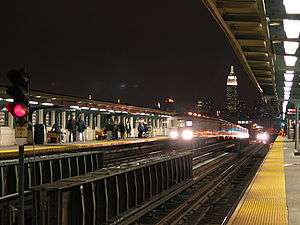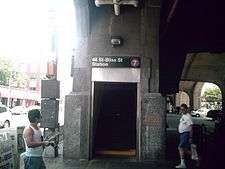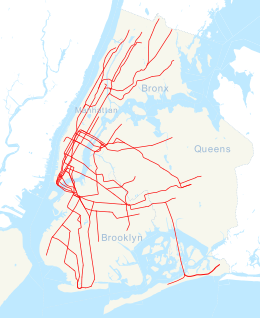46th Street–Bliss Street station
46th Street–Bliss Street is a local station on the IRT Flushing Line of the New York City Subway. Located at the intersection of 46th Street and Queens Boulevard in Sunnyside, Queens, it is served by the 7 train at all times.
46 Street–Bliss Street | |||||||
|---|---|---|---|---|---|---|---|
 Looking west at two Flushing-bound 7 trains approaching 46th Street-Bliss Street station at night | |||||||
| Station statistics | |||||||
| Address | 46th Street & Queens Boulevard Sunnyside, NY 11104 | ||||||
| Borough | Queens | ||||||
| Locale | Sunnyside | ||||||
| Coordinates | 40°44′35.28″N 73°55′6.25″W | ||||||
| Division | A (IRT) | ||||||
| Line | IRT Flushing Line | ||||||
| Services | 7 | ||||||
| Transit connections | |||||||
| Structure | Elevated | ||||||
| Platforms | 2 side platforms | ||||||
| Tracks | 3 | ||||||
| Other information | |||||||
| Opened | April 21, 1917 | ||||||
| Station code | 458[1] | ||||||
| Accessible | not ADA-accessible; accessibility planned | ||||||
| Opposite-direction transfer available | Yes | ||||||
| Former/other names | Bliss Street | ||||||
| Traffic | |||||||
| Passengers (2019) | 4,019,044[2] | ||||||
| Rank | 121 out of 424[2] | ||||||
| Station succession | |||||||
| Next north | 52nd Street: 7 | ||||||
| Next south | 40th Street–Lowery Street: 7 | ||||||
| |||||||
| |||||||
| |||||||
History
The Flushing Line was opened from Queensboro Plaza to Alburtis Avenue (now 103rd Street–Corona Plaza) on April 21, 1917, with a local station at 46th Street.[3]
The platforms at 46th Street were extended in 1955–1956 to accommodate 11-car trains.[4]
In December 2019, the Metropolitan Transportation Authority announced that this station would become ADA-accessible as part of the agency's 2020–2024 Capital Program.[5]
Station layout
| P Platform level | ||
| Side platform | ||
| Southbound local | ← | |
| Peak-direction express | ← | |
| Northbound local | | |
| Side platform | ||
| M | Mezzanine | Fare control, station agent, MetroCard machines |
| G | Street level | Entrances/exits |

This elevated station has three tracks and two side platforms. The center track is used by the rush hour peak direction <7> express train. This is the easternmost (railroad north) station on the IRT Flushing Line's concrete viaduct above Queens Boulevard. East of here, the line curves north and becomes elevated over Roosevelt Avenue.
Each platform has concrete windscreens painted in beige and green canopies in the center and waist-high beige barriers at either side. The windscreens contain stained glass windows as part of an artwork called "Q is For Queens" by Yumi Heo installed in 1999. They depict various images related to Heo's children book illustrations. This can also be found on the station's main entrance.
Exits
This station has two entrances/exits, both of which are station houses built within the viaduct's concrete structure. The main one is at the west (geographic south) end of the station and has two staircases and one turnstile bank to each platform, token booth, and four street stairs built within the viaduct's support pillars. These stairs lead to all four corners of 46th Street and the parking lot underneath the viaduct and between the two sides of Queens Boulevard. This entrance does not allow a free transfer between directions (even though it has the layout that could allow one as both turnstile banks lead to the center of the station house).[6]
The station's other entrance is unstaffed, containing just HEET and exit-only turnstiles, two staircases to each platform, and two street stairs, also built within the support pillars, going down to either western corners of 47th Street and the parking lot. This entrance has a waiting area that allows a free transfer between directions.[6]
Naming

46th Street was originally named simply Bliss Street after early ferry operator and industrialist Neziah Bliss, whose other namesakes include the nearby neighborhood of Blissville. His name was dropped from the street in the 1920s. The subway station retained the name until 1998, during which time the station name was the inspiration for the electronic band 46bliss. In 1998, the MTA removed it from maps and signage, but by 2003, neighborhood activist Pat Dorfman collected 1,900 signatures, successfully lobbying the MTA and the City Council to restore the old street and station names. The MTA did so in 2004, and the Council added the ceremonial name; street intersection signs near the station now feature a secondary Bliss St plaque.[7]
References
- "Station Developers' Information". Metropolitan Transportation Authority. Retrieved June 13, 2017.
- "Facts and Figures: Annual Subway Ridership 2014–2019". Metropolitan Transportation Authority. 2020. Retrieved May 26, 2020.
- "Transit Service on Corona Extension of Dual Subway System Opened to the Public". The New York Times. April 22, 1917. p. RE1. Retrieved October 2, 2011.
- Authority, New York City Transit (1955). Minutes and Proceedings.
- "Press Release - MTA Headquarters - MTA Announces 20 Additional Subway Stations to Receive Accessibility Improvements Under Proposed 2020-2024 Capital Plan". MTA. December 19, 2019. Retrieved December 20, 2019.
- "MTA Neighborhood Maps: Jackson Heights" (PDF). Metropolitan Transportation Authority. 2015. Retrieved September 27, 2015.
- Karni, Annie (October 7, 2012). "Subway stations retain signs listing places and streets that no longer exist". New York Post. Archived from the original on May 2, 2014. Retrieved May 2, 2014.
External links
| Wikimedia Commons has media related to 46th Street – Bliss Street (IRT Flushing Line). |
- nycsubway.org – IRT Flushing Line: 46th Street/Bliss Street
- nycsubway.org — "Q" is For Queens Artwork by Yumi Heo (1999) along with the 40th Street — Lowery Street and the 33rd Street — Rawson Street stations.
- Station Reporter — 7 Train
- The Subway Nut — 46th Street–Bliss Street Pictures
- MTA's Arts For Transit — 46th Street–Bliss Street (IRT Flushing Line)
- 46th Street entrance from Google Maps Street View
- 47th Street entrance from Google Maps Street View
- Platforms from Google Maps Street View



